

Speech Pauses: 12 Techniques to Speak Volumes with Your Silence. Effective use of speech pauses is a master technique.

If you do it right, nobody is conscious of your pauses, but your ideas are communicated more persuasively. If you do it wrong, your credibility is weakened, and your audience struggles to comprehend your message. In this article, we examine: benefits of effective speech pauses;techniques for using pauses naturally (there are more than you think); andcommunications research which provides clues to why pauses help us communicate effectively. Vocal Delivery Article Series Benefits of Effective Speaking Pauses Pausing is one of the most overlooked delivery techniques, but there are many benefits of using pauses effectively. 1. Pauses allow you to punctuate your spoken words, giving your listeners clues as to when one phrase, one sentence, or one paragraph ends, and the next begins. Research says: Brigitte Zellner (PDF paper) notes that pauses “participate in rendering human communication more intelligible.” 2. 3. 4.
Chunk 6. ELF Pronunciation. Not only do these speeches give you goosebumps, they also provide exposure to a variety of accents!
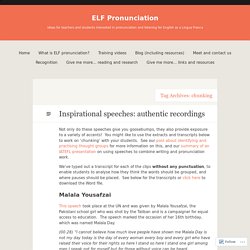
You might like to use the extracts and transcripts below to work on ‘chunking’ with your students. See our post about identifying and practising thought groups for more information on this, and our summary of an IATEFL presentation on using speeches to combine writing and pronunciation work. We’ve typed out a transcript for each of the clips without any punctuation, to enable students to analyse how they think the words should be grouped, and where pauses should be placed. See below for the transcripts or click here to download the Word file. Malala Yousafzai This speech took place at the UN and was given by Malala Yousafzai, the Pakistani school girl who was shot by the Taliban and is a campaigner for equal access to education.
Note (1): You may like to just focus on the first paragraph above, as it is better to keep texts fairly short when working on chunking. Nelson Mandela Dalai Lama. University of Technology Sydney. Pauses and chunks package information for the listener.
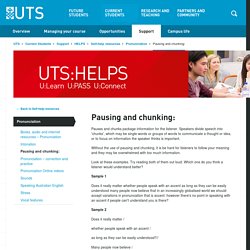
Speakers divide speech into 'chunks', which may be single words or groups of words to communicate a thought or idea, or to focus on information the speaker thinks is important. Without the use of pausing and chunking, it is be hard for listeners to follow your meaning and they may be overwhelmed with too much information. Look at these examples. Try reading both of them out loud. Which one do you think a listener would understand better? Reading Aloud. Module 2: Orchestral Speech.
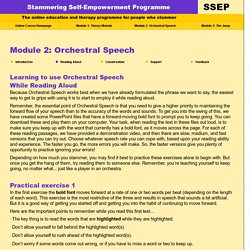
288. The Importance of Fluency and Automaticity for Efficient Reading. By Pamela E.
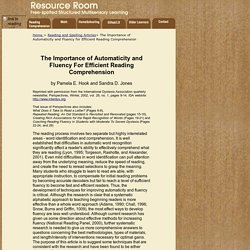
Hook and Sandra D. Jones Reprinted with permission from the International Dyslexia Association quarterly newsletter, Perspectives, Winter, 2002, vol. 28, no. 1, pages 9-14. IDA website: That issue of Perspectives also includes: What Does it Take to Read a Letter? 4 reading strategies to help your students read with purpose. A few months ago when I was “cleaning” (or at least going through the motions of it), I took a break to look through a few random literary collections.
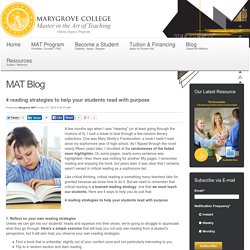
One was Mary Shelly’s Frankenstein, a book I hadn’t read since my sophomore year of high school. As I flipped through the novel nearly fifteen years later, I chuckled at the randomness of the faded neon highlighter. On some pages, nearly every sentence was highlighted—then there was nothing for another fifty pages. I remember reading and enjoying the book, but years later, it was clear that I certainly wasn’t versed in critical reading as a sophomore lad. 5 Ways to Help your Students with Critical Reading and Reading Critically. If our students had a dollar for every time we said, “You need to start reading critically,” they’d be millionaires by Christmas!

Like critical thinking, critical reading is something many teachers take for granted because we know how to do it. But we need to remember that critical reading is a learned strategy, one that we must teach our students. Active Reading How to Read with a Purpose Tutorial. Teaching Reading Comprehension Strategies. Classroom Strategies.
Seven Strategies to Teach Students Text Comprehension. 1.

Monitoring comprehension Students who are good at monitoring their comprehension know when they understand what they read and when they do not. They have strategies to "fix" problems in their understanding as the problems arise. Research shows that instruction, even in the early grades, can help students become better at monitoring their comprehension. Reading.pdf. Reading with Purpose in the Content Areas. Home › Professional Development › Strategy Guides Strategy Guide Content area teachers in middle and high schools face sometimes misguided pressure from administrators to include more reading in their instructional activities.

While it’s likely that being asked to read (with reasonable support) in every classroom would improve standardized test scores, that’s a side benefit to the real reasons to make sure that reading is a part of students’ content area learning. Reading is a way to gain exposure to and develop tentative understandings of content. Teacher talk, even when supported by audiovisual aids, tends to dominate content area instruction—often at the expense of engaged student learning. Essential Strategies.